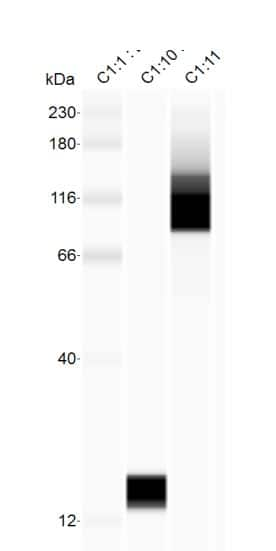| Reactivity | ETSpecies Glossary |
| Applications | WB, ELISA, Flow, GS, ICC/IF, IHC, IP, ChIP, KO |
| Clonality | Polyclonal |
| Host | Rabbit |
| Conjugate | Unconjugated |
| Concentration | 0.1 mg/ml |
| Immunogen | This HA Tag Antibody was developed by immunizing rabbits with HA cleavage site (YPYDVPDYA) conjugated to KLH. Antibody was isolated by affinity chromatography using the peptide immobilized on solid support. |
| Isotype | IgG |
| Clonality | Polyclonal |
| Host | Rabbit |
| Purity | Immunogen affinity purified |
| Innovator's Reward | Test in a species/application not listed above to receive a full credit towards a future purchase. |
| Dilutions |
|
|
| Application Notes | Use in Gel Super Shift Assays reported in scientific literature (PMID:34289349). Use in ChIP reported in (PMID: 30659200).. Use in IHC reported in (PMID: 22880041).. Use in FLOW reported in scientific literature (Pryce R et al).. Knockout validation (PMID: 32354171).. Recommended dilution for coating ELISA plates is 1:100 - 1:500. |
|
| Reviewed Applications |
|
|
| Publications |
|
| Storage | Store at 4C. Do not freeze. |
| Buffer | PBS |
| Preservative | 0.09% Sodium Azide |
| Concentration | 0.1 mg/ml |
| Purity | Immunogen affinity purified |
| Images | Ratings | Applications | Species | Date | Details | ||||||||
|---|---|---|---|---|---|---|---|---|---|---|---|---|---|

Enlarge |
reviewed by:
Tanya Kutyavin |
Simple Western | Human | 06/08/2018 |
Summary
|
||||||||
|
reviewed by:
Filipa Franquinho |
WB | Human | 05/04/2013 |
Summary
|
|||||||||

Enlarge |
reviewed by:
Maria Andreou |
WB | Other | 09/26/2011 |
Summary
|
Secondary Antibodies |
Isotype Controls |
Research Areas for HA Tag Antibody (NB600-363)Find related products by research area.
|
|
Developmental regulator Daam2 promotes glial cell tumors by degrading Von Hippel-Lindau protein By Jamshed Arslan Pharm.D. Glioblastoma is an aggressive type of cancer that forms from the star-shaped glial cells of the central nervous system, called astrocytes. Intriguingly, several genes linked to glioblasto... Read full blog post. |
The concentration calculator allows you to quickly calculate the volume, mass or concentration of your vial. Simply enter your mass, volume, or concentration values for your reagent and the calculator will determine the rest.
5 | |
4 | |
3 | |
2 | |
1 |
| Tanya Kutyavin 06/08/2018 |
||
| Application: | Simple Western | |
| Species: | Human |
| Filipa Franquinho 05/04/2013 |
||
| Application: | WB | |
| Species: | Human |
| Maria Andreou 09/26/2011 |
||
| Application: | WB | |
| Species: | Other |